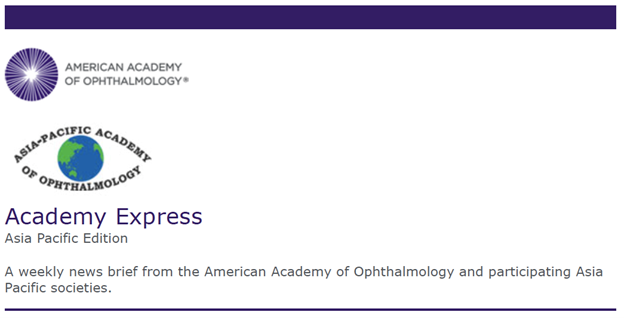เผยแพร่ผลงานวิจัยของจักษุแพทย์ไทย ในจดหมายข่าว Academy Express
Updated 2022-07-04 20:56:00

Academy Express เป็นจดหมายข่าว อิเล็กทรอนิกส์ ที่จัดทำโดย American Academy of Ophthalmology ส่งทาง email ทุกสัปดาห์ ถึงสมาชิกของ 19 องค์กร วิชาชีพทางจักษุวิทยาใน Asia Pacific region รวมทั้ง RCOPT ราชวิทยาลัยฯเชิญชวนสมาชิกจักษุแพทย์ ติดตาม ผลงานวิจัยของจักษุแพทย์ไทย ในคอลัมน์ ASIA PACIFIC JOURNAL STUDIES ในจดหมายข่าวดังกล่าว
Academy Express Asia
Pacific Edition ฉบับวันที่ 25 Jun 2022
Optic neuritis caused by MOG antibody may be
associated with COVID-19 infection
In this
case study, a 35-year-old Thai woman presented with reported acute blurred
vision in her left eye with pain on eye movement for 6 days; she also had had a
dry cough for 1 week before the onset of visual loss. Visual acuity was 20/32
in the right eye. She also had bilateral disc swelling which was more prominent
in the left eye. Imaging showed a swollen optic nerve sheath complex in both
eyes. She subsequently tested positive for COVID-19 infection and had a
positive serology test for serum anti-myelin oligodendrocyte glycoprotein (MOG)
antibody; therefore, she was diagnosed with COVID-19-associated MOG antibody
optic neuritis. This case, along with several others reported in the literature,
suggests that there may be an association between COVID-19 infection and MOG
antibody-associated disease; however, larger
case-controlled studies are required to confirm these findings.
American
Journal of Ophthalmology Case Reports, June 2022
https://pubmed.ncbi.nlm.nih.gov/35313470/
Academy Express Asia
Pacific Edition ฉบับวันที่ 18 Jun 2022
Inaccurate PIC
diagnoses have been seen with anterior segment OCT imaging
A cross-sectional study evaluated the diagnostic
performance of manual grading of anterior segment OCT (AS-OCT) in the detection
of plateau iris configuration (PIC) based on the presence of standardized
ultrasound biomicroscopy (UBM) criteria. One hundred seventy-nine eyes were
analyzed, and 47.5% were diagnosed as having PIC. Interobserver agreement rates
of primary angle closure by the 3 graders, based on AS-OCT images, were between
0.68 and 0.70. The accuracy of the manual graders in detecting PIC from AS-OCT
images ranged from 51.2% to 65.0%. Given these data, AS-OCT imaging does not
appear to be a good substitute for UBM in PIC detection and is not recommended
for use in patients with primary angle closure.
BMJ Open Ophthalmology, March 2022
https://pubmed.ncbi.nlm.nih.gov/35402728/
Academy Express Asia Pacific
Edition ฉบับวันที่ 11 Jun 2022
Lasers and
Orbscan create different parameter measurements for the Implantable Collamer
Lens
Horizontal corneal white-to-white (WTW) and
anterior chamber depth (ACD) measured by Orbscan are the parameters commonly
used for calculating size of the Implantable Collamer Lens (ICL), a phakic IOL.
However, Orbscan is not always available in every refractive surgery center, and
it has also been withdrawn from distribution. This retrospective review of 83 eyes
with ICL implantation (42 patients) compared WTW and ACD measured from machines
incorporated with WaveLight femtosecond and excimer laser systems
with those measured with Orbscan. The measurements taken with the two
laser systems were in good agreement with the Orbscan measurements; however,
there was a statistically significant difference in the proportion of eyes with
unacceptable postoperative vaults between the laser systems data set and the
Orbscan data set (14.5% vs 6.0%, respectively). Therefore, the Orbscan and
laser system WTW and ACD measurements may not be interchangeable when selecting
ICL size.
BMJ Open Ophthalmology, March 2022
https://pubmed.ncbi.nlm.nih.gov/35372697/
Academy Express Asia
Pacific Edition ฉบับวันที่ 4 Jun 2022
The ANTERION
optical biometer has performance comparable to that of GALILEI G6
In a prospective study conducted at a tertiary
eye center, investigators compared the performance of a new swept-source OCT
optical biometer, ANTERION, in ocular biometrics and IOL calculations vs the reference
standard of the dual Scheimpflug analyzer GALILEI G6 in 96 eyes with cataracts.
Eyes were scanned with both devices in a random fashion, and parameters were
analyzed in terms of mean difference and intraclass correlation coefficients.
There were significant differences in all parameters between the devices, with the
exception of anterior chamber depth, but excellent agreement. The mean
difference in axial length between ANTERION and GALILEI G6 was 0.03 mm. Calculated
IOL power revealed that 94% were within 1 D; the prediction error was 0.03 D.
While ANTERION and GALILEI G6 calculate IOL and perform other biometric tasks
equally well, it is important to note that the devices cannot be used interchangeably.
Scientific Reports, March 2022
https://pubmed.ncbi.nlm.nih.gov/35246594/
Academy Express Asia
Pacific Edition ฉบับวันที่ 28 May 2022
Levator
resection shows efficacy in severe ptosis with poor levator function
In a retrospective interventional study, data
from 38 ptotic eyelids in 31 patients with severe simple congenital ptosis and
levator function of 34 mm who had undergone maximal levator resection beyond
Whitnall ligament were reviewed to evaluate the functional and cosmetic
outcomes of surgery as well as the factors that influenced surgical success.
Successful surgical outcomes, defined as "at least good functional and
cosmetic outcomes," were achieved in 84% of patients at 12 months after
surgery. The only factor that significantly influenced the surgical success
rate was the length of the resected levator muscle; the mean lengths in the
successful and unsuccessful groups were 18.15 mm and 14.29 mm, respectively.
Therefore, this surgical approach is highly effective in patients with severe
simple congenital ptosis and poor levator function.
Clinical Ophthalmology, February 2022
https://pubmed.ncbi.nlm.nih.gov/35210749/
Academy Express Asia
Pacific Edition ฉบับวันที่ 21 May 2022
Pediatric
pleomorphic liposarcoma is rare and may be treatment refractory.
Thai investigators report a case of a primary
orbital pleomorphic liposarcoma in an 11-year-old boy with an enlarging, painless
lower right eyelid mass that was discovered 4 months prior to the clinician visit.
Imaging revealed a large, well- circumscribed lobulated mass, and a biopsy revealed
a pleomorphic spindle cell neoplasm consistent with pleomorphic liposarcoma
presentation. There was no evidence of distant metastasis. The patient underwent
4 chemotherapy cycles, but at the 12-week follow-up visit the mass was found to
have grown larger. A total orbital exenteration was then performed, and at 6 months
after surgery there were no signs of liposarcoma recurrence.
American Journal of Ophthalmology
Case Reports, March 2022
https://pubmed.ncbi.nlm.nih.gov/35146183/
Academy Express Asia
Pacific Edition ฉบับวันที่ 14 May 2022
Anatomic and
visual improvements in PCV are seen with aflibercept injections
Investigators conducted a multicenter prospective
study to determine the timing of complete polypoidal regression on indocyanine
green angiography (ICGA) after aflibercept injections for polypoidal choroidal
vasculopathy (PCV) in 40 eyes. Eligible eyes received fixed-dose aflibercept
injections monthly for 3 months, then every 8 weeks for 1 year (or monthly if
fluid persisted on OCT). Two retina specialists reviewed post- treatment ICGAs
and categorized them as complete regression (complete disappearance of
polypoidal lesions), partial regression (reduced in size or number), or no
regression. At 2 months after aflibercept injections were given, complete
polypoidal regression was seen in 11 of the 40 eyes (27.5%); median duration of
time from baseline to achieve complete regression was 3 months. Eyes that had
achieved complete polypoidal regression also had significantly better visual
acuity (median letter gain) than those who had not. These findings support the
consideration of aflibercept for PCV.
Ophthalmology Retina, January 2022
https://pubmed.ncbi.nlm.nih.gov/33781929/
Academy Express Asia
Pacific Edition ฉบับวันที่ 7 May 2022
Combination of acyclovir and ganciclovir shows
efficacy in EBV- associated uveitis
A
retrospective cohort study was conducted in 22 patients
with Epstein-Barr virus (EBV)-associated uveitis to
determine the characteristics of the disease as well as treatment outcomes. The
primary assessment was treatment success, defined by clinical improvement and
absence of viral DNA confirmed by polymerase chain reaction (PCR). Sixty-seven
percent of patients had human immunodeficiency virus infection; cytomegalovirus
(38%) was the most common co-infecting pathogen.
Seventy-three percent of patients had undetectable EBV infection in the
intraocular fluid after treatment; the most widely used treatment regimen was a
combination of systemic acyclovir and intravitreal ganciclovir injection (58% of patients). Journal of Clinical Virology, January 2022
https://pubmed.ncbi.nlm.nih.gov/35007895/
Academy Express Asia
Pacific Edition ฉบับวันที่ 30 Apr 2022
Improvements
in visual outcomes are seen with vitrectomy plus ILM peeling
A Thai retrospective cohort study evaluated the
visual outcomes and macular anatomic structures seen with spectral-domain OCT (SD-OCT)
in 14 patients with epiretinal membrane foveoschisis who underwent 23G vitrectomy
and internal limiting membrane (ILM) peeling. The main outcomes were best-corrected
visual acuity (BCVA) and anatomic appearance on SD-OCT assessed during
preoperative evaluations and postoperative follow-ups at 1, 3, 6, and 12 months.
Significant improvements in BCVA were observed at the 3-, 6-, and 12-month postoperative
visits. At month 12, there were vision improvements of 23 lines in 57% of
patients and vision improvements of 1 or 2 lines in 14% of patients. Nearly all
patients achieved anatomical foveal restoration; only one had persistent intraretinal
schisis at 12 months. No significant visual impairments were observed.
BMC Ophthalmology, December 2021
https://pubmed.ncbi.nlm.nih.gov/34911498/
Academy Express Asia
Pacific Edition ฉบับวันที่ 23 Apr 2022
Dry eye
symptoms worsened during the COVID-19 lockdown period in Thailand
Investigators assessed the impact of COVID-19
lockdown measures on dry eye symptoms through a community-based,
cross-sectional study conducted during the first wave of the COVID-19 outbreak
in Thailand (June and July 2020). An online survey was distributed via social
media with questions about demographics, dry eye symptoms (scores ranging from 0
= always having symptoms to 4 = no symptoms), and the use
of visual display terminals (VDTs). Of the 535 respondents, 37% reported being
diagnosed with dry eye disease (DED). During the COVID-19 lockdown period, the
overall mean dry eye symptom scores significantly decreased, from 81.6 to 79.8,
while the mean daily VDT usage increased from 10.55 to
13.08 hours. Female gender (odds ratio [OR] 1.86) and increased VDT usage
during the lockdown (OR 5.68) were independently associated with worsening dry
eye symptoms.
Scientific Reports, December 2021
https://pubmed.ncbi.nlm.nih.gov/34952901
Academy Express Asia
Pacific Edition ฉบับวันที่ 16 Apr 2022
Vitreous
syphilis antibody tests can help confirm syphilitic uveitis
A prospective case-control study was carried out
to determine the sensitivity and specificity of syphilis antibody tests in
vitreous samples. Enzyme immunoassay (EIA) had the greatest sensitivity in
detecting vitreous syphilitic antibody (90.9%), followed by rapid plasma regain
(80.0%) and fluorescent treponemal antibody-absorption (FTA-ABS) (78.9%), The
EIA and FTA-ABS tests had the highest specificity as well, detecting 100% of
the syphilis antibody. The results show that vitreous syphilis antibody tests
have potential as supplementary methods of confirming syphilitic uveitis.
Eye (London), January 2022
https://pubmed.ncbi.nlm.nih.gov/35034091/
Academy Express Asia
Pacific Edition ฉบับวันที่ 9 Apr 2022
The Krimsky
test provides an accurate measurement of angle of deviation in strabismus
Investigators in Thailand compared the Photo-Hirschberg
and Krimsky tests' measurements of angle of deviation with the measurement from
an alternate prism cover test (APCT) in 33 patients with horizontal strabismus.
The angle of deviation measured with the APCT was used as the baseline
comparator. For the Photo- Hirschberg test, patients were photographed and the
images analyzed with computer software, and then the corneal light reflex displacement
was converted into prism diopter. Twenty-eight patients were also given the
Krimsky test. The Krimsky test was found to be more reliable than the Photo-Hirschberg
test for measuring angle of deviation.
PLOS One, December 2021
https://pubmed.ncbi.nlm.nih.gov/34851974/
Academy Express Asia
Pacific Edition ฉบับวันที่ 2 Apr 2022
A deep
learning algorithm may have future use in diabetic retinopathy screening
In this study, validation of the clinical performance
of an automated diabetic retinopathy (DR) screening model was conducted, in
preparation for future real-life application. The model analyzed 2533 Nidek camera
fundus images and 1989 Eidon camera images of DR cases. In the training phase,
the Nidek-trained model achieved a sensitivity of 93% and a specificity of 91%,
whereas the Eidon-trained model achieved an 88%
sensitivity and an 85% specificity. During the clinical verification phase, the
sensitivity and specificity for the Eidon model were similar to that seen in
the first phase, but the sensitivity of the Nidek model declined from the first
phase to 82%. Therefore, the images from the Eidon camera yielded a more
desirable performance from the deep learning algorithm model in differentiating
referable DR than did the images from the Nidek camera. This algorithm is a
potential alternative for standard DR screening tools in real-world clinical
care settings.
Translational Vision Science & Technology,
November 2021
https://pubmed.ncbi.nlm.nih.gov/34767624/
 RCOPT
RCOPT